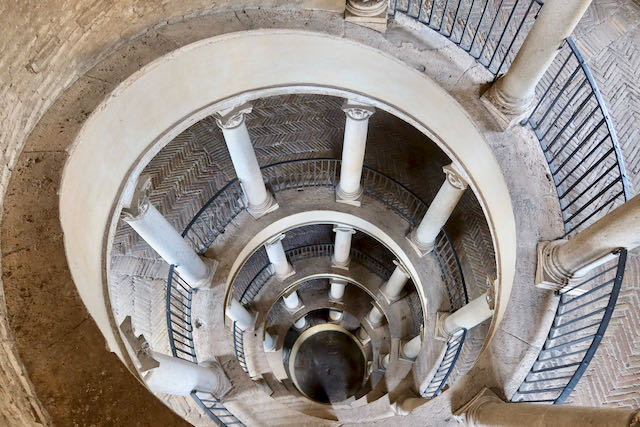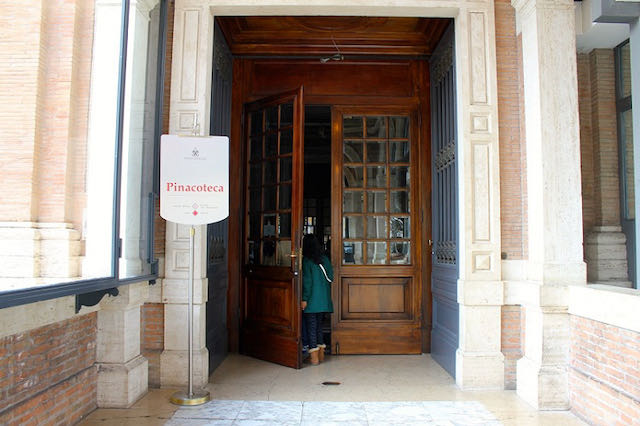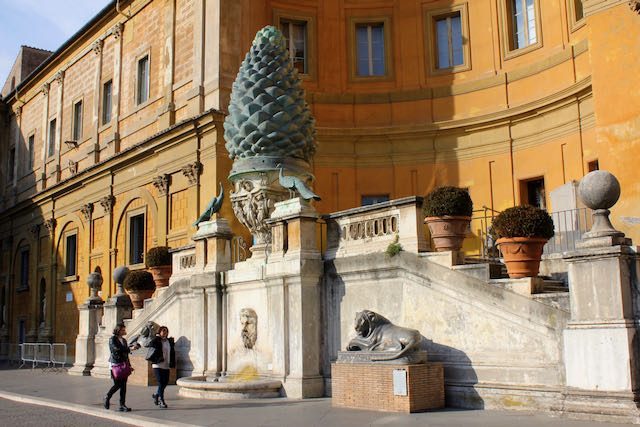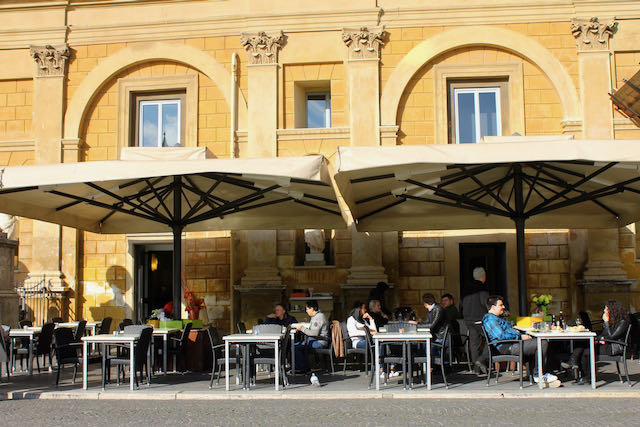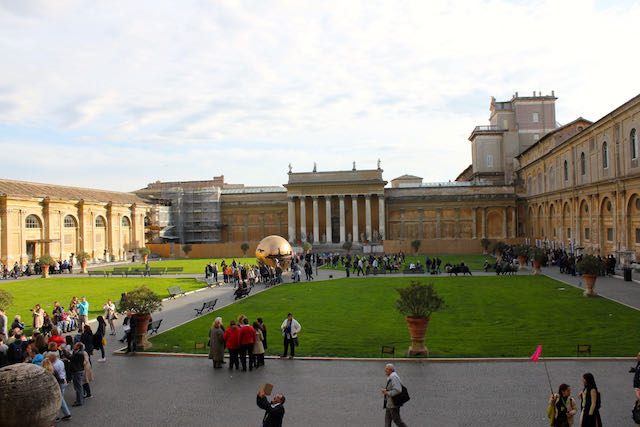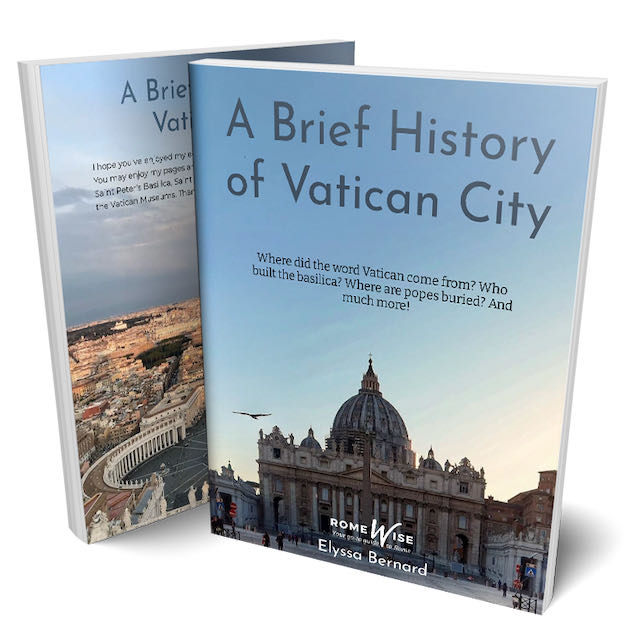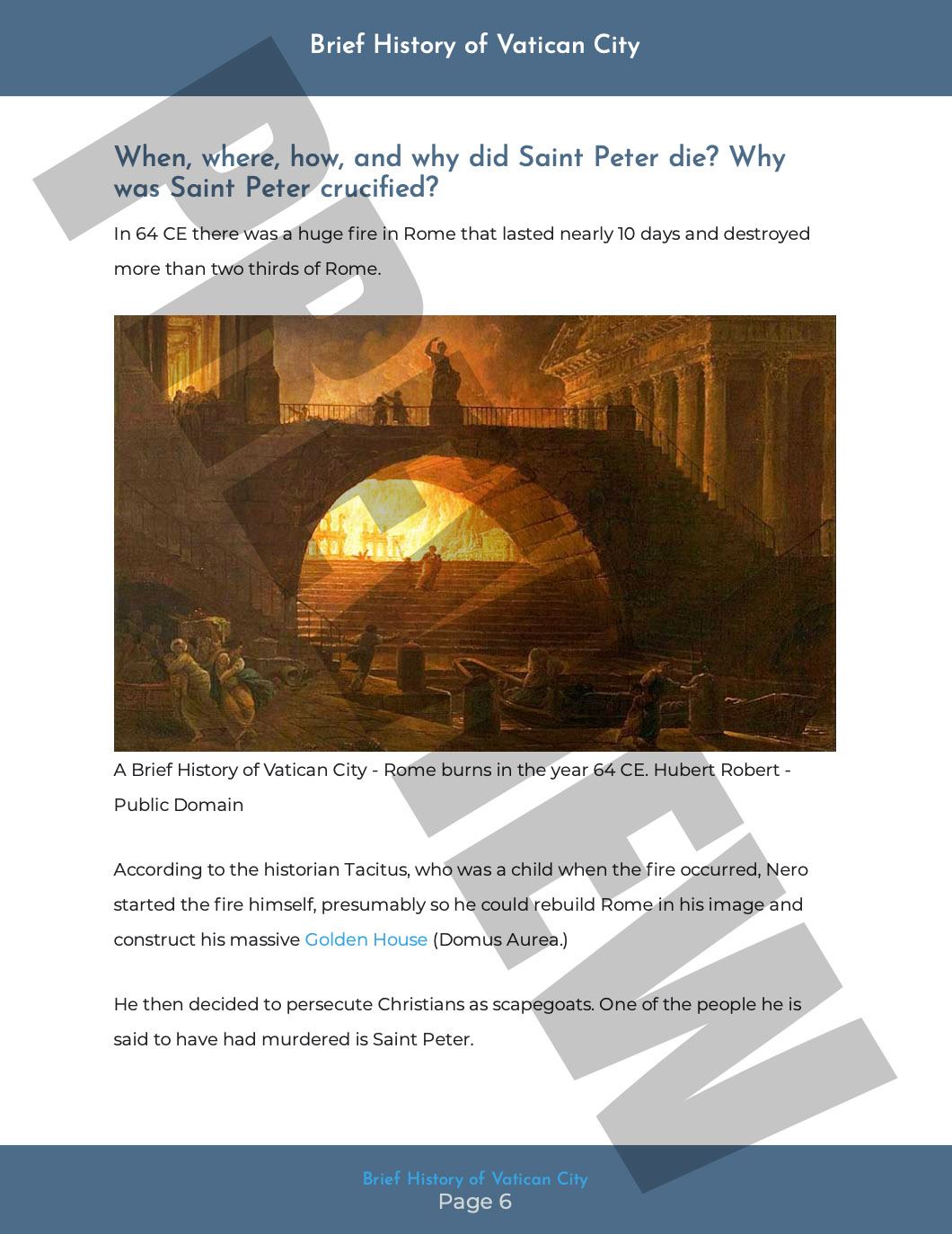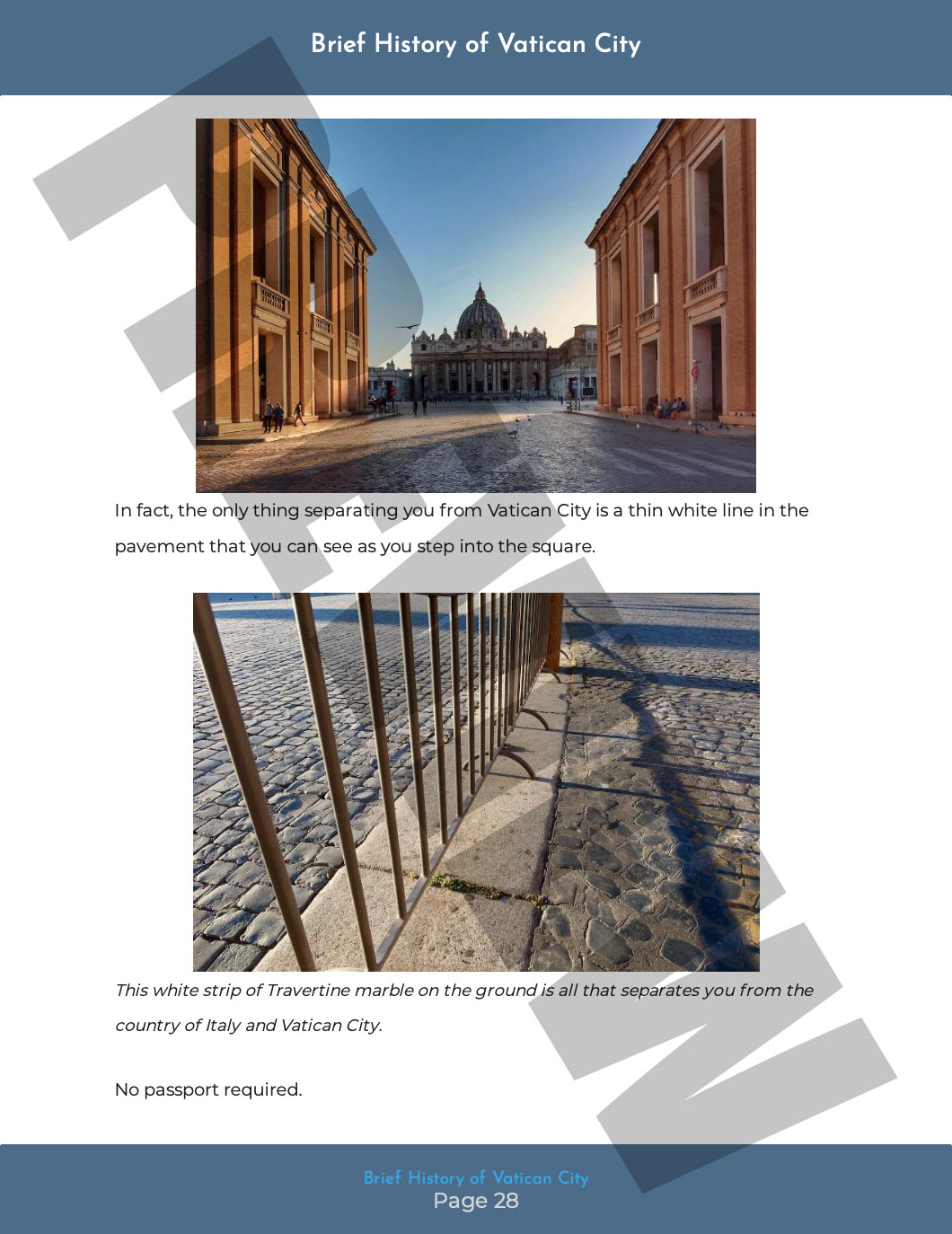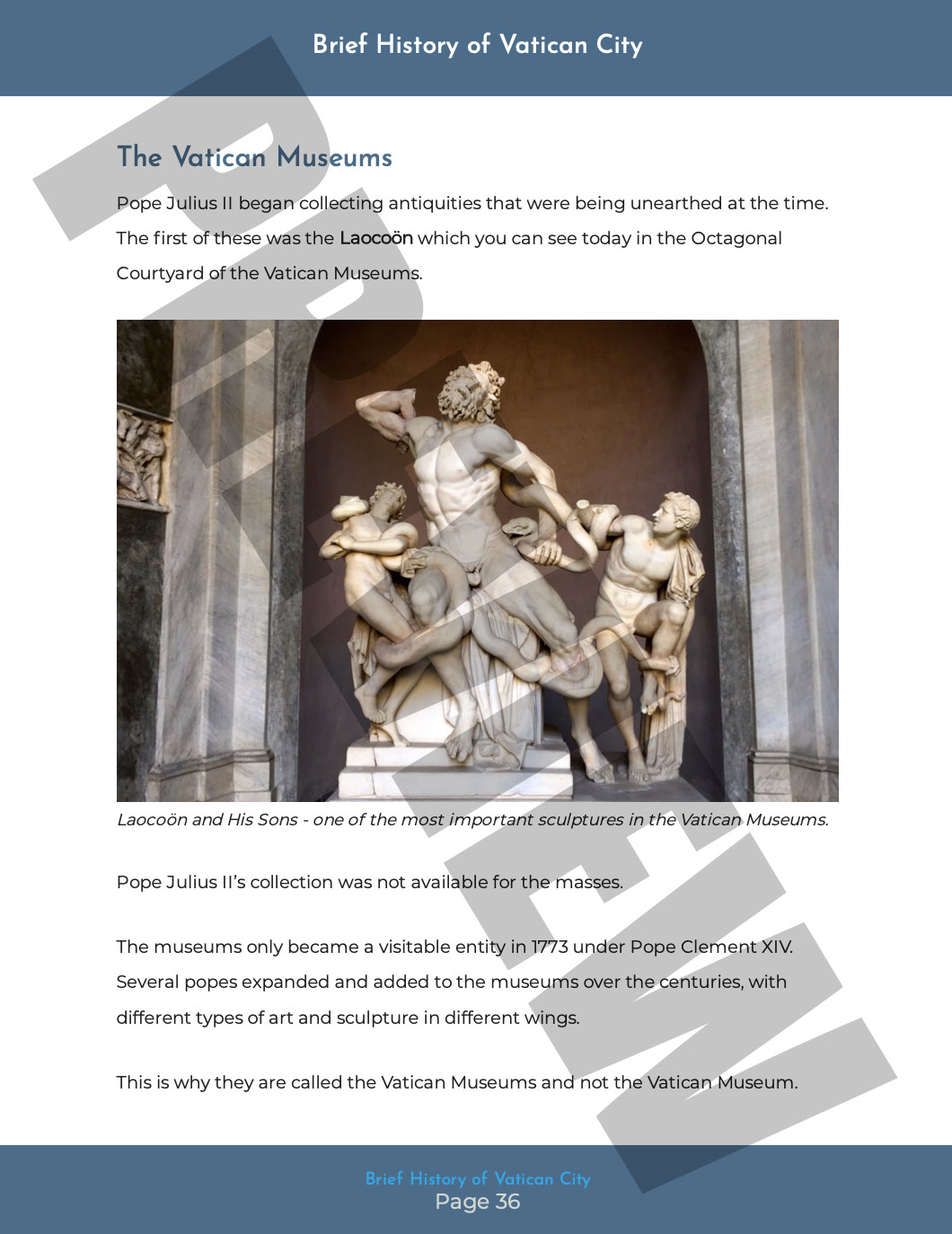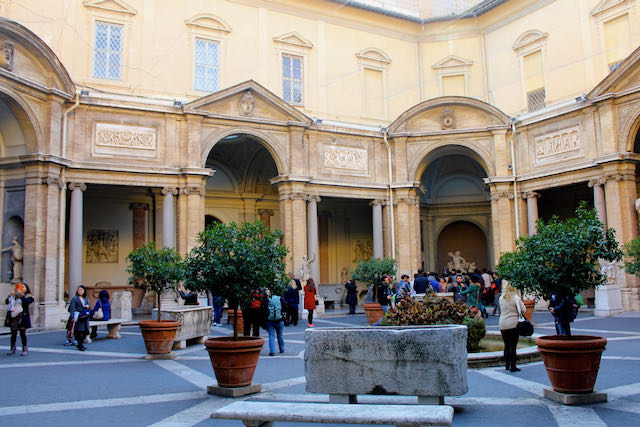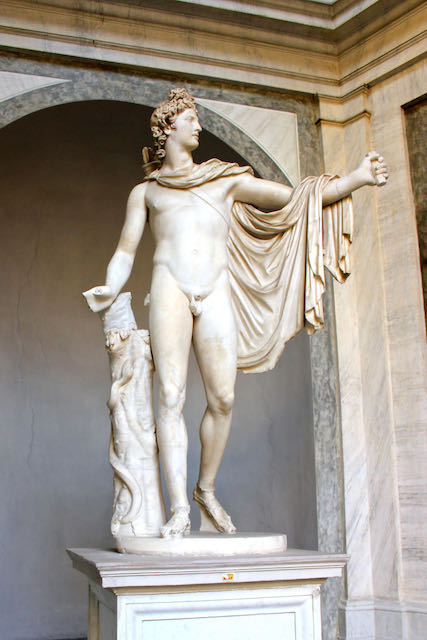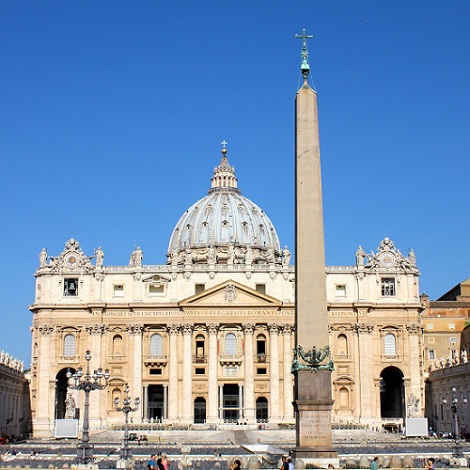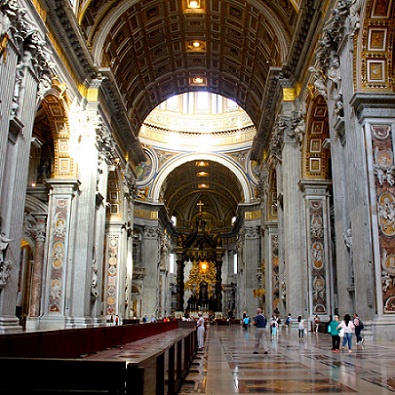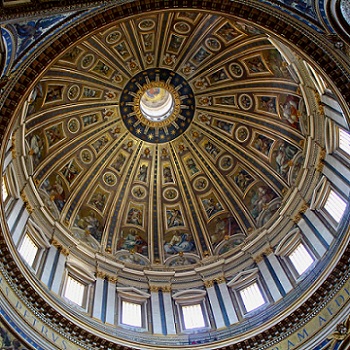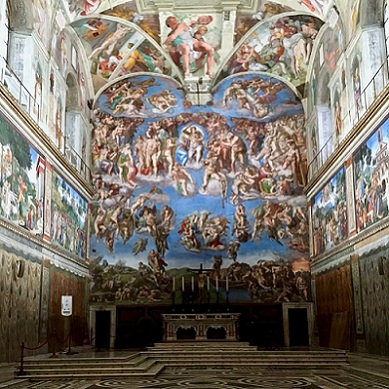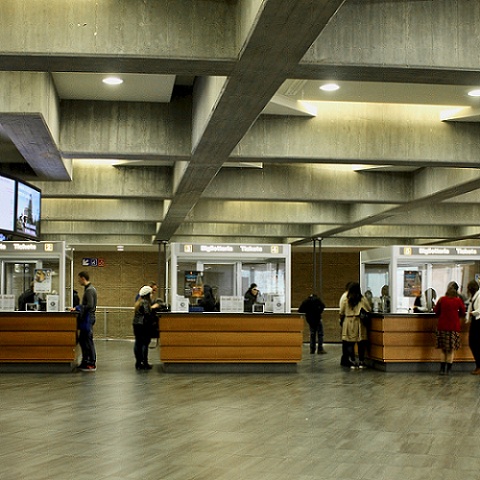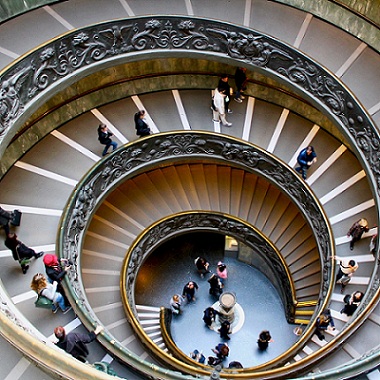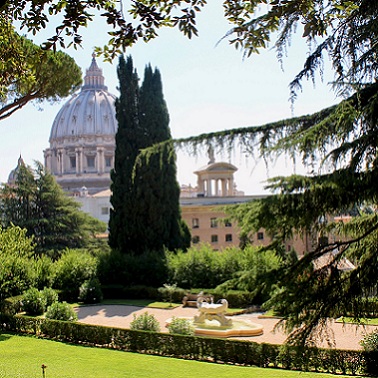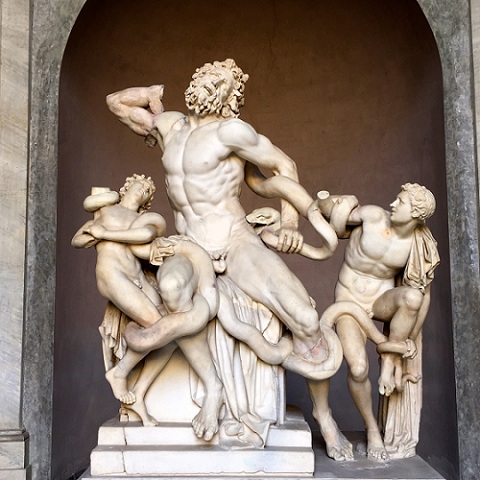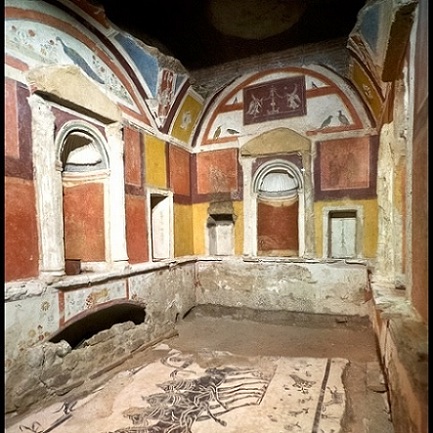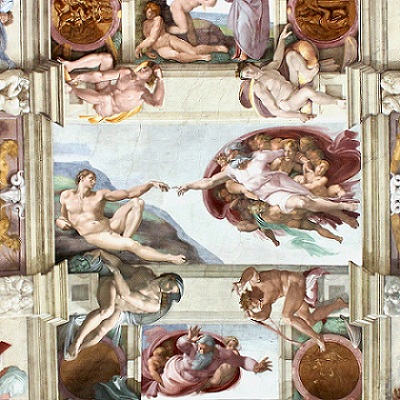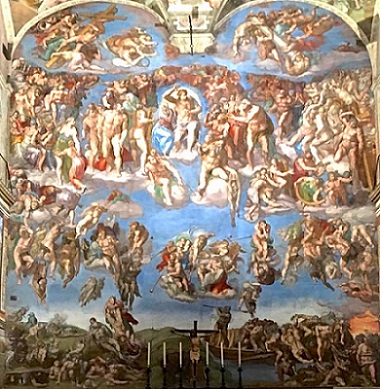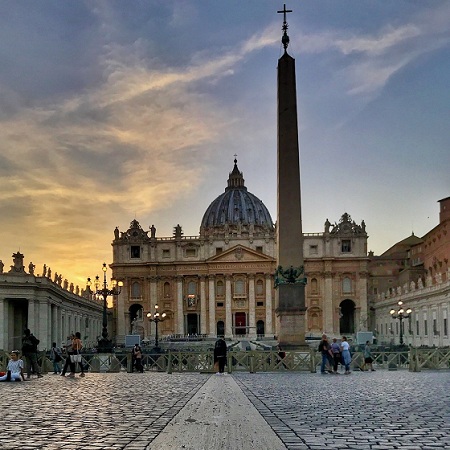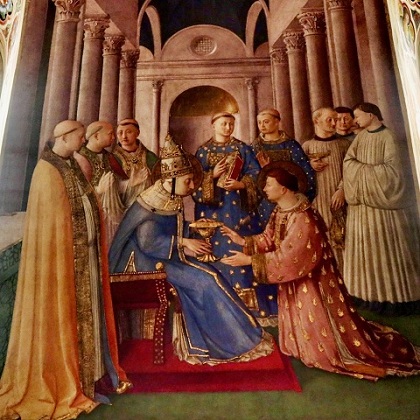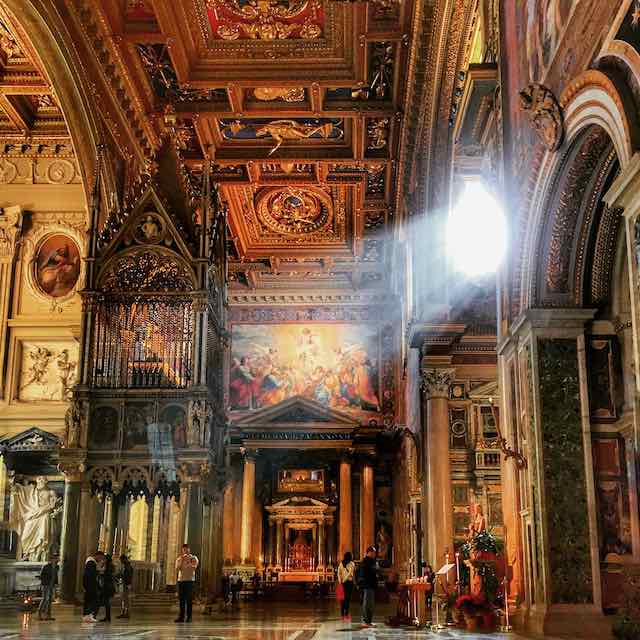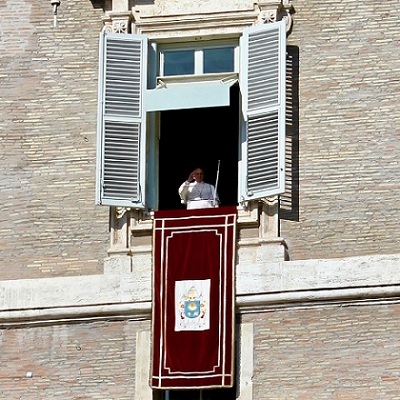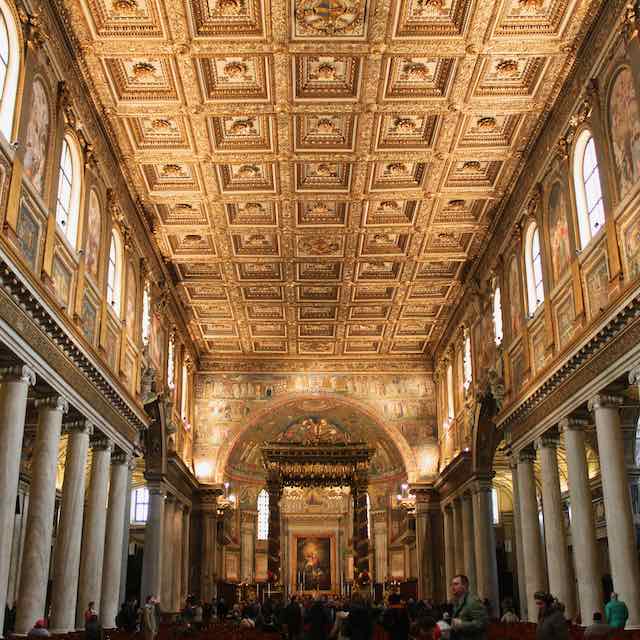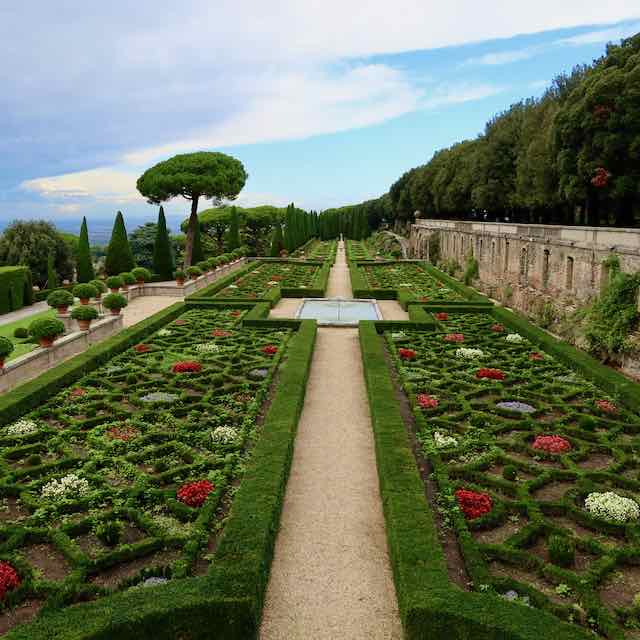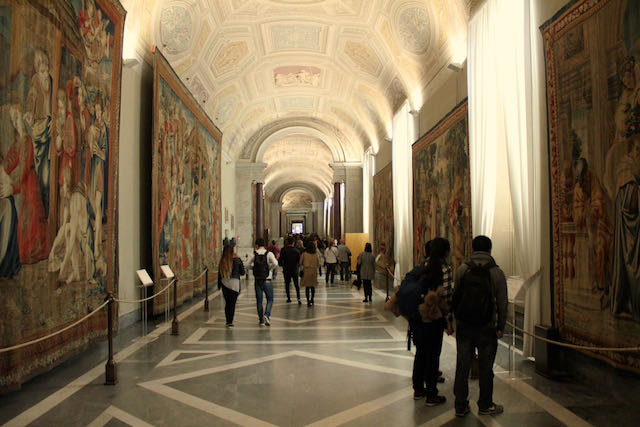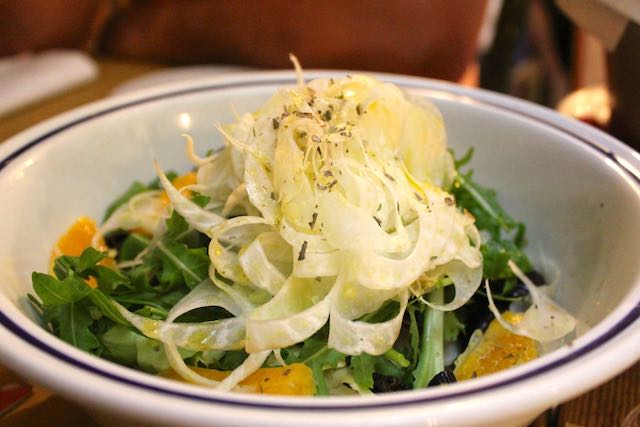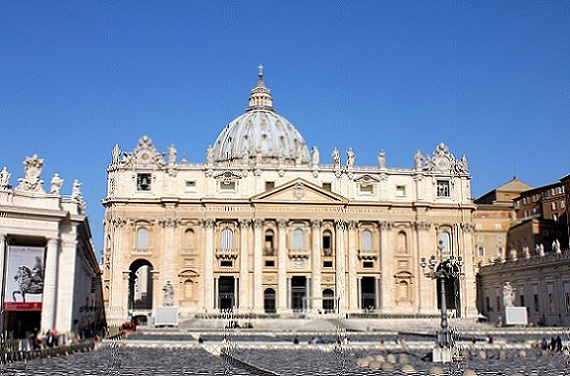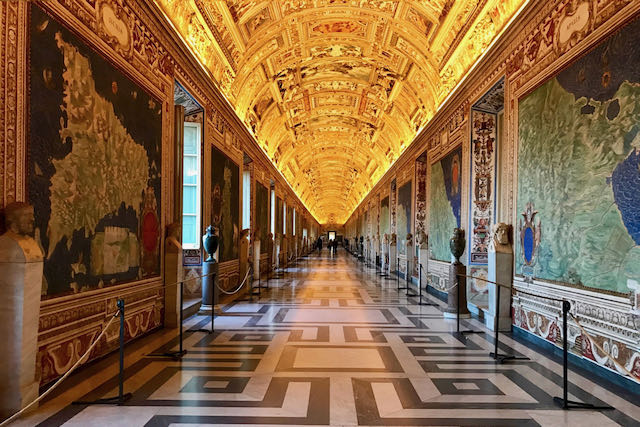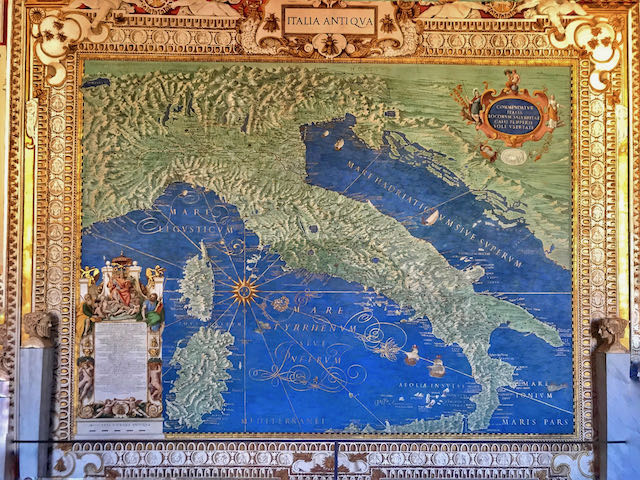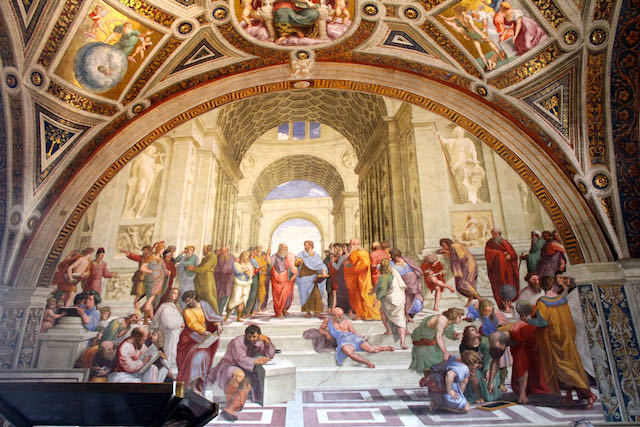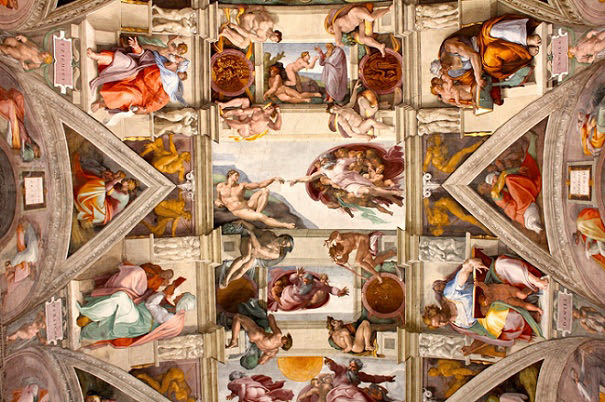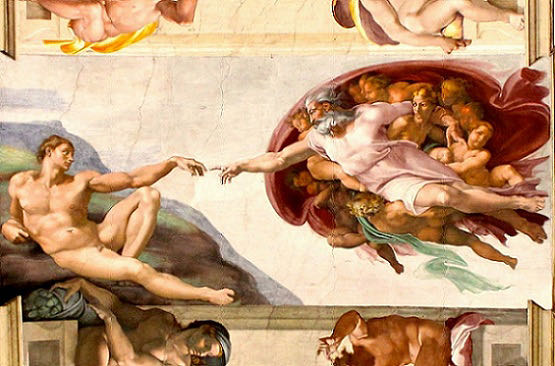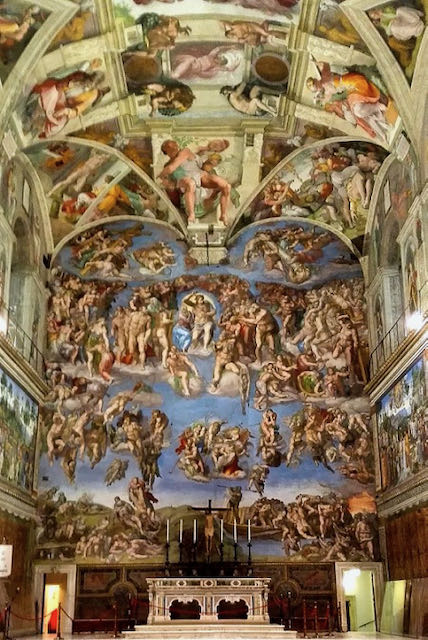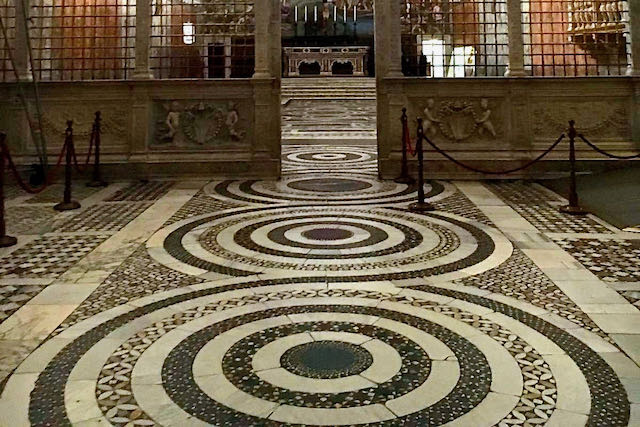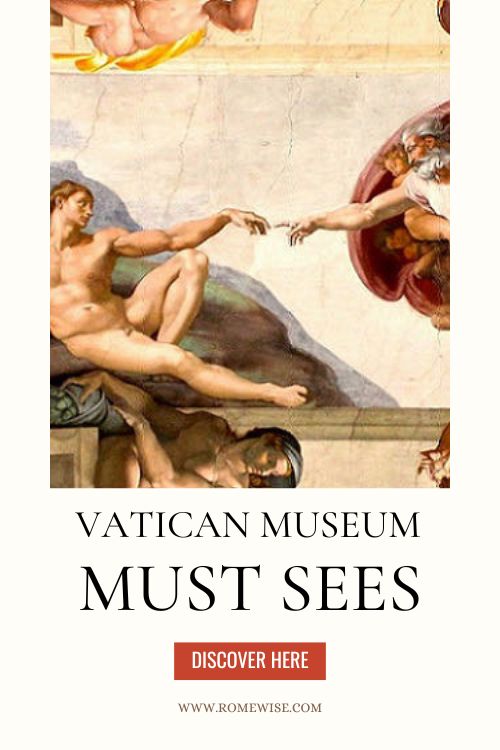- Sign up & get a FREE ebook Subscribe NOW!
- Romewise Home Page
- Visiting the Vatican
- Vatican Museum Must Sees
Vatican Museum Must Sees - 10 stunning works not to miss!
What are the top 10 Vatican Museum Must Sees?
With over 7 kilometers of art galleries, the Vatican Museums are among the largest in the world.
Find out what not to miss!
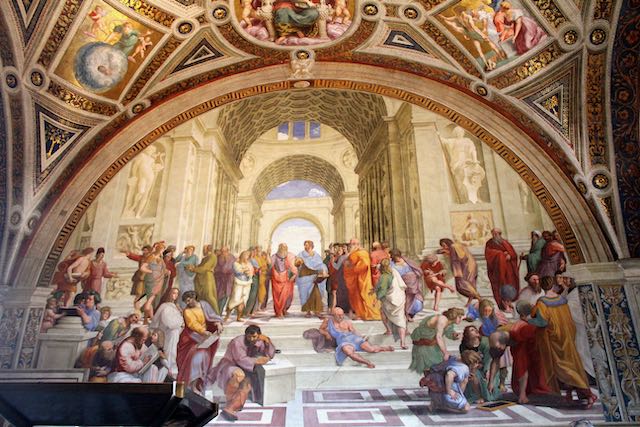 Raphael's famed School of Athens in the Raphael Rooms of the Vatican Museums is a must-see. Find out what else not to miss!
Raphael's famed School of Athens in the Raphael Rooms of the Vatican Museums is a must-see. Find out what else not to miss!Why a Top 10 List of Vatican Museum Must Sees
There is so much to see in the Vatican Museums, if I listed it all the things I consider "must-see" here, this page would be way too long to follow (it's already pretty long, and I had to contain myself!)
And, frankly, as often as I have visited the Vatican museums, I always see something new.
Whether it's your first time visiting the Vatican Museums, or you have limited time and just want to make sure you see the highlights, there are some important works in the Vatican Museums you should not miss.
Some of these are things you will see no matter how you visit the museums.
For example, everyone ends up at the Sistine Chapel, so there is no chance of missing that.
But there are some other things you will have to make a decision to include.
And, some of the things on this list are entire rooms, so I'll let you know the most important thing(s) to see there.
In order of how you walk through the museums, these Vatican Museum Must Sees include, but are not limited to:
- The Spiral Staircase
- Raphael's Transfiguration
- Pinecone Courtyard
- Laocoön
- Apollo Belvedere
- The Rotunda Room and Porphyry Basin
- The Tapestries Hall
- The Maps Room
- Raphael's School of Athens
- The Sistine Chapel
Of course, my list is subjective.
The beauty of art is in the eye of the beholder.
There are pieces I love that I've left off this list, but the idea is to give you some of the most important, and most iconic things to see in the Vatican Museums.
Disclosure: If you make a purchase through a link on this page, I may receive a small commission - at no extra cost to you. Thank you for supporting my site!
Vatican Museum Must Sees - The Spiral Staircase
There is a very special staircase you cannot normally visit in the Vatican museums, designed by Bramante.
And in 1932, architect Giuseppe Momo designed another one, which was inspired by the original Bramante Staircase.
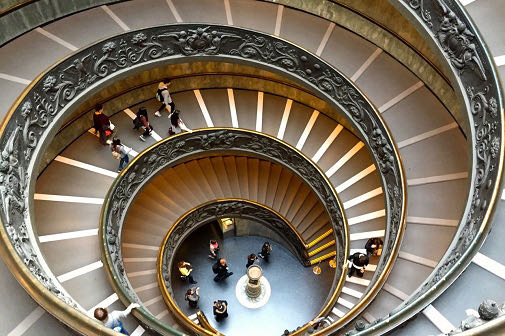 This spiral staircase in the Vatican Museums makes a lovely photo - find out how not to miss seeing this!
This spiral staircase in the Vatican Museums makes a lovely photo - find out how not to miss seeing this!His staircase, like Bramante's, is a double helix (like DNA).
It is composed of two staircases which theoretically allow people to go up and down without crossing each other.
I say theoretically because this staircase is now intended ONLY as the exit from The Vatican Museums.
If you are visiting the Vatican museums with a tour that includes Saint Peter's Basilica, you will not exit the museums via this staircase, as you go from the Sistine Chapel directly into St. Peter's Basilica.
Depending on the tour company, the guide might show you this staircase at the very beginning of the tour so you don't miss it.
You might consider asking the guide to show it to you.
If you visit the museums on your own, and for whatever reason do not want to or cannot visit Saint Peter's Basilica using the shortcut (which is only possible with a booked tour of the museum that ends in Saint Peter's basilica) from the Sistine Chapel, you will take the exit from the Sistine Chapel that takes you back out to the entrance of the Vatican Museums.
In this case, you will visit this staircase on your way out.
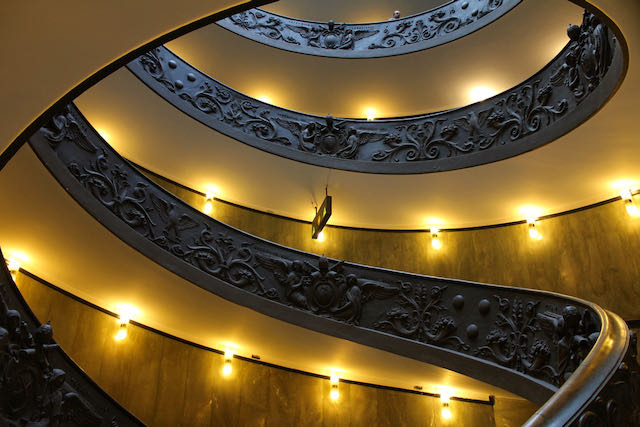 This is the view of the Vatican Museums spiral staircase from the bottom, in case you do exit this way. It's beautiful from every angle!
This is the view of the Vatican Museums spiral staircase from the bottom, in case you do exit this way. It's beautiful from every angle!Why this is in my list of Vatican Museum Must Sees:
I don't think this was the intention when it was created, but it has become one of the most photographed things in the Vatican museums.
If you want to see the original Bramante staircase, you can book a special tour that includes this staircase, plus other things in the Vatican Museums not normally open to the public.
Vatican Museum Must Sees - The Pinacoteca
The Vatican Pinacoteca is the paintings gallery of the Vatican Museums.
It is often overlooked and under-visited.
To me this is a shame, because there are several masterpieces in there.
The Pinacoteca is one of the latest additions to the Vatican Museums, completed in 1931.
There are mostly paintings but also a few other works like tapestries, icons and sculptures.
The works are from the Middle Ages through the 1800's and are in chronological order, covering 18 rooms.
To visit the Pinacoteca, either book a tour that includes this, or, if going on your own, visit this first.
Once you come up the big escalators at the entry and into the museums, the Pinacoteca will be on your right.
There are so many works by artists I love, including Caravaggio's Deposition, but the jewel in the crown so to speak, is Raphael's last work right before he died: the Transfiguration.
🇻🇦 Visit the Vatican 🇻🇦
Experience the best of the Vatican.
Enjoy easy access to the Vatican Museums, Sistine Chapel,
and St. Peter’s Basilica for an unforgettable experience
with these recommended tours.
Raphael's Transfiguration
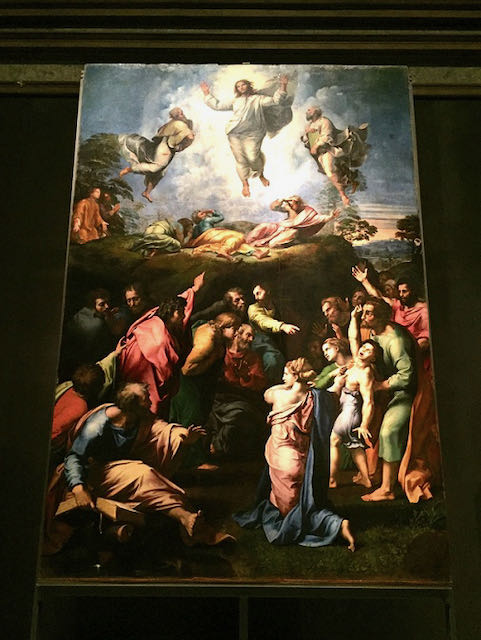 Raphael's masterpiece, The Transfiguration, was his last work before he died. It's one of the most iconic paintings in the Vatican Museums Pinacoteca
Raphael's masterpiece, The Transfiguration, was his last work before he died. It's one of the most iconic paintings in the Vatican Museums PinacotecaThe Transfiguration relates to stories of the Gospel of Matthew, and depicts the dual human and divine nature of Jesus Christ.
The top half is painted in light colors and shows Jesus flanked by the prophets Elijah and Moses.
He seems to be the only serene one in the painting.
The bottom half is dark, because it's an earthly painting with a human, dark scene.
On the right side we see a boy who is apparently possessed (he has epilepsy.)
His parents are anguished, and the apostles are shown with a look of wonder on their faces, as they realize that Jesus Christ not only lives on, but that faith can cure the sick boy.
Their outstretched arms link the bottom with the top of the painting.
It was commissioned by Cardinal Giulio de' Medici, who was to become Pope Clement VII.
Raphael had not quite finished it when he died prematurely in 1520 (that is another story.)
The painting was originally meant to be an altarpiece for a church in France, but the pope decided to keep it in Rome.
Later, it did make its way to France when Napoleon got his hands on it for a while.
But the painting finally wound up in the Pinacoteca of the Vatican Museums.
Lucky for us!
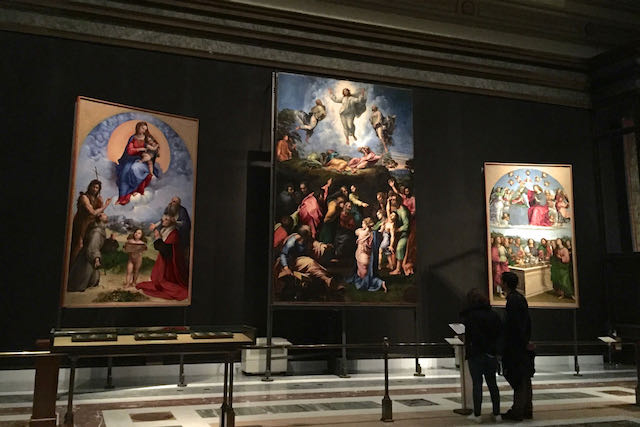 Raphael's Transfiguration is in a perfect setting: flanked by two other of his paintings, and in a semi-dark, large room, you can get a good look up close, or from farther back to take it all in
Raphael's Transfiguration is in a perfect setting: flanked by two other of his paintings, and in a semi-dark, large room, you can get a good look up close, or from farther back to take it all inWhy is this painting so significant and why is it on my list of Vatican Museum Must Sees?
The Transfiguration is seen as the bridge between what is called "High Renaissance" painting (early 1500's), and "Baroque style" painting (early 1600's.)
Raphael used chiaroscuro ("light on dark", a technique made even more famous by Caravaggio), to highlight the darkness of the sick boy on earth (at the bottom of the painting), and the lightness of Jesus's body in heaven (at the top of the painting).
And unlike so many of Raphael's previous paintings, including in the Raphael rooms in the Vatican Museums, the figures in this painting portray extreme and very human emotions: awe, disbelief, anguish.
This painting inspired Michelangelo's "The Last Judgement", on the wall of the Sistine Chapel.
So the painting is not only amazing to look at, but it's a very important piece as far as art history and art appreciation go.
(If you'd like to read a more detailed analysis of this painting, visit the Encyclopedia of Art website.)
I can spend at least an hour wandering the rooms of the Pinacoteca.
But if you want to just go through to the room (room VIII) with the Transfiguration, you can do so easily, and get back out, in less than 20 minutes.
You can also see it while on a guided tour through the Vatican Museums
Vatican Museum Must Sees - The Pinecone Courtyard
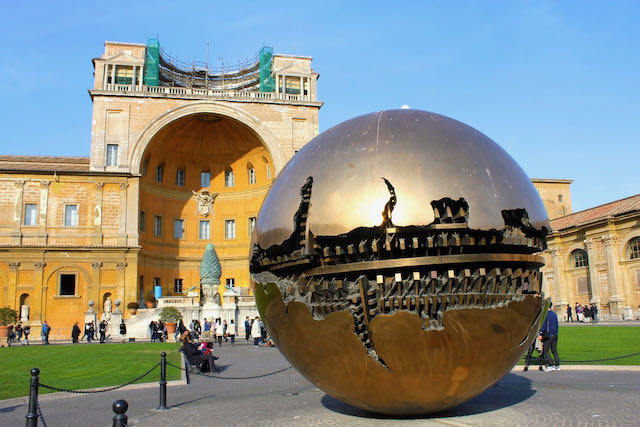 This modern art bronze sphere by Arnaldo Pomodoro in the Pinecone Courtyard may be one of the most photographed things in the Vatican Museums.
This modern art bronze sphere by Arnaldo Pomodoro in the Pinecone Courtyard may be one of the most photographed things in the Vatican Museums.The Pinecone Courtyard, or Cortile della Pigna, is named for the nearly 13-foot high pinecone sitting at one end.
The giant pinecone is made of bronze and dates to the 1st century BCE.
It was originally found in the Campus Martius (Campo Marzio) area of Rome, which is near the Pantheon.
The two bronze peacocks on either side of the pine cone are copies of ancient sculptures that flanked an entrance to Hadrian's Mausoleum (today Castel Sant'Angelo.)
The originals can be seen in the Braccio Nuovo wing of the Vatican Museums.
The Pinecone Courtyard is part of what was once a much longer space, designed in 1506 by Donato Bramante (the first guy to design the cuppola of Saint Peter's Basilica, before Michelangelo finished the job.
He also built that staircase I told you about above.)
That courtyard, called the Belvedere Courtyard, was meant to link the Vatican Palace (where the pope lived) with the Villa Belvedere (a sort of pleasure resort with a nice view of Rome, hence its name "Belvedere.")
Today the Villa Belvedere has been turned into part of the Vatican Museums.
The Belvedere Courtyard was a first in its design and became the inspiration for courtyard design around the world for centuries to come.
Later, a library was built across the middle of it, making this courtyard smaller (the one you see today.)
Neither the library nor the other half of the courtyard are open to visitors.
So what about that pinecone?
It was found near the Pantheon around the Baths of Agrippa (the guy who first built the Pantheon, and who was also Emperor Augustus' right-hand man.)
The pinecone was once a giant fountain, with water coming out of the top and scales and running down the sides.
Can you just imagine how lovely that must have been?
Since these were pre-Christian times, the pinecone was (probably) part of a pagan temple, dedicated to Isis.
In mystic or occult circles, the pine cone also represents the pineal gland, which is responsible for our perception of light.
The pineal gland (and so the pine cone), are symbols of the "third eye", which is the so-called “Epicenter of Enlightenment."
I do not mean to go off on an existential tangent here, but I do think that having a symbol like this, flanked by two peacocks, in the middle of the Vatican Museums, is an interesting juxtaposition.
For a very special treat, you can book this early-morning tour of the Vatican Museums and Sistine Chapel, that starts with breakfast right in the Pinecone courtyard!
Why is the Pinecone courtyard on my list of Vatican Museum Must Sees?
First of all, I think the pinecone in itself is fascinating, since it is from ancient Rome, but also has hidden meaning.
Second, because, like the spiral staircase, the strange modern art globe in the center is another of the most photographed things in the Vatican Museums (despite it being pooh-poohed for being...too modern? too weird? And yet, people seem to love it!)
Third, because it does give you what I think is a needed moment of fresh air and open space to rest, gather your thoughts and impressions, and re-group for the rest of the museums.
It's hard to miss seeing this courtyard but I suppose you could you if you were on a fast-track to the Sistine Chapel.
To see it, stop by after visiting the Pinacoteca.
The visit could take you anywhere from 10 minutes and up, depending on how much time you spend resting, taking pix or even grabbing a bite at the cafe there.
Brief History of Vatican City eBook
The history of the Vatican stretches back thousands of years, and to know everything about this incredible micro-state would take a lifetime to learn.
With this eBook, discover the brief history of Vatican City - where it got its name, who built the basilica, where the Popes are buried and more!
Topics covered include:
- Details about the Vatican's origin, going back to the time of Ancient Rome
- The role important artists such as Michelangelo played in the creation of the Vatican as we know it today
- How the Vatican came to be an independent city state within the boundaries of Rome
What else is included in this Brief History of Vatican City e-book?
- 50+ pages of information covering all areas of the Vatican's history
- Dozens of stunning and original photos showcasing the Vatican
- Insightful diagrams and drawings to help illustrate the more detailed elements of the Vatican's history
- + much more!
Jump start your trip to Rome with a free ebook 😀
Sign-up to our free newsletter and receive our Quick Start Guide to Rome ebook which share's everything you need to know to plan the perfect trip to the Eternal City 🙌
Vatican Museum Must Sees - The Pio-Clementine Museums
The Pio-Clementine museum houses some of the best examples of ancient Greek and Roman sculptures found anywhere in the world.
The museum is named for the two popes who oversaw its foundation in the late 1700's: Clement XIV and Pius VI.
This museum is pretty large and houses many different rooms, each fascinating and chock full of things to see in its own right.
It's easy to skip this museum if you are on a fast-track to the Sistine Chapel, so if you want to see these Vatican Museum must sees, you will need to make a decision to include this museum.
As you start making your way through the Pio-Clementine museums, you will come upon an open-air courtyard, called the Octagonal Courtyard (for its shape).
It would be easy to simply walk through it to the other side and keep going.
By this time, you will have already come across lots of sculptures.
I know how one can get overwhelmed by all these ancient Greek and Roman statues ... and start getting sculpture fatigue.
But while to me it is worth really soaking up all the art in here, there are at least two Vatican Museum Must Sees right in this courtyard.
The perfect 3-day itinerary in Rome
Trying to figure out how to organize your visit to Rome? I've got the perfect 3-day itinerary for first-time visitors (or those who have not been here in a while.) It works for a 2.5 day visit as well.
In my 3-day itinerary, you'll see all the major must-see Rome attractions like the Vatican, Colosseum, Trevi Fountain, Pantheon, Piazza Navona, Spanish Steps, and much more.
And if you have more time, or want suggestions for extra/other things to do, you'll find that there too.
Visit my page with the best 3-day itinerary in Rome for first-timers.
Laocoön
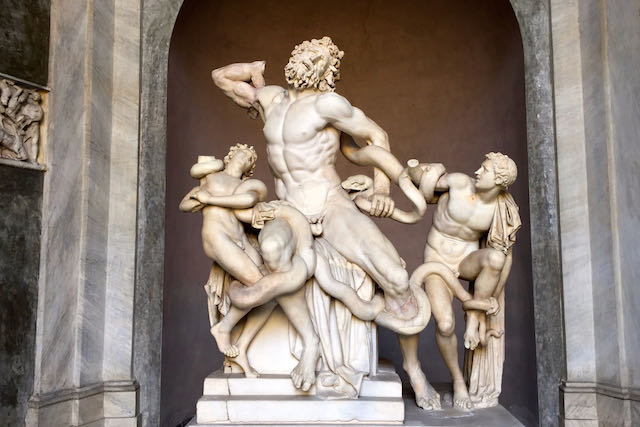 The Laocoön sculpture in the Vatican Museums is one of the most important pieces of art in the collection, and a must see
The Laocoön sculpture in the Vatican Museums is one of the most important pieces of art in the collection, and a must seeThe Laocoön is a sculpture group, found in 1506 on the Esquiline Hill in Rome.
The sculpture, from around 30 BCE, depicts the Trojan priest Laocoön and his two sons losing a battle to the death with two sea serpents.
Pliny the Elder had described a statue just like this, as being a masterpiece made by three sculptors from Rhodes, and residing in the palace of the Roman Emperor Titus (part of the Flavian Dynasty, who built the Colosseum.)
It's pretty well accepted that this is the statue Pliny was referring to, although this statue may have been a copy from a 2nd century BCE original.
The Laocoön sculpture depicts a moment from Virgil's Aeneid, which recounts the Trojan War.
You may remember a scene in which the Greeks leave a giant wooden horse outside the gates of Troy.
The Trojans naïvely bring in the horse, and subsequently the Greeks who'd been hiding in the horse jump out and destroy Troy.
Laocoön, a Trojan priest, had warned the Trojans not to bring in the horse.
The gods Athena and Poseidon, who sided of course with the Greeks, sent two sea serpents to kill the priest.
Aeneas heeded the priest's warning and fled Troy, bound for Italian shores.
And for Romans, this is a big deal, since Aeneas was one of the forefathers of Romulus and Remus, the legendary founders of Rome.
Why is the Laocoön sculpture on my list of top 10 Vatican Museum Must Sees?
First of all, as I said, the story itself is important to the founding legend of Rome.
And, second of all, this sculpture is pretty special, considering that it depicts real human agony, with dignity, and without any redemptive qualities that later Christian art shows of saints and martyrs.
It is considered by many to be one of the highest-quality sculptures in the world.
You can visit the sculpture with a guide as well - it's included in walking tours, such as this one.
Vatican Museum Must Sees - Apollo del Belvedere
The Apollo Belvedere is a marble Greek sculpture from around the 1st century BCE (although it was probably a Roman copy of an earlier bronze statue made by the Greek sculptor Leochares.)
It was once considered one of the greatest ancient sculptures ever made.
The statue was found in the 15th century, and belonged to Cardinal Giuliano della Rovere.
Once he was elected as Pope Julius II, he had the statue moved to the Vatican, into the Belvedere Courtyard (hence its nickname.)
It was the first piece in the art collection of the Vatican, before there were Vatican Museums.
The sculpture portrays the god Apollo, (who existed in both Greek and Roman mythology), as an archer who just shot an arrow.
His face is serene, and even the relaxed body portrays a god who is at ease, and unchallenged by the effort of shooting his arrow.
The sculpture shows the "ideal" male body, without a single flaw.
In the 18th century, the height of neo-classicism, the German art historian Johann Joachim Winckelmann said, "of all the works of antiquity that have escaped destruction, the statue of Apollo represents the highest ideal of art."
During the Romantic movement, around the late 1800's, the Apollo Belvedere started to lose its appeal and today is no longer considered the height of artistic beauty.
So why is the Apollo Belvedere in my list of Vatican Museum Must Sees?
First, because it was once considered to be the ideal of classical male beauty.
Second, because this is the piece that began the entire collection in the Vatican Museums.
Third, it was said to be Napolean's favorite piece of art that he took from the Vatican to the Louvre (of course after Napolean's fall, this statue and most of the rest of the art he took was returned to Rome and in this case, to the Vatican.)
If you do take the time to visit the Pio-Clementine museum, and want to see some more special exhibits, you can add in the Gregorian Egyptian museum, with its superb collection of papyri, mummies and ancient statues.
One floor up from this is the Gregorian Etruscan museum, with extraordinary examples of Etruscan relics, including a life-sized Etruscan tomb that you can walk into and enjoy a well-done video and light-show presentation.
And these museums are almost always empty so it's a moment of respite and calm from the otherwise frenetic and crowded Vatican Museums.
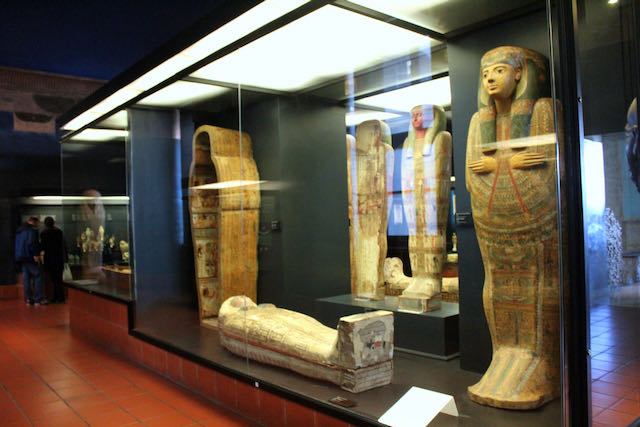 Mummies in the Egyptian wing of the Vatican Museums
Mummies in the Egyptian wing of the Vatican Museums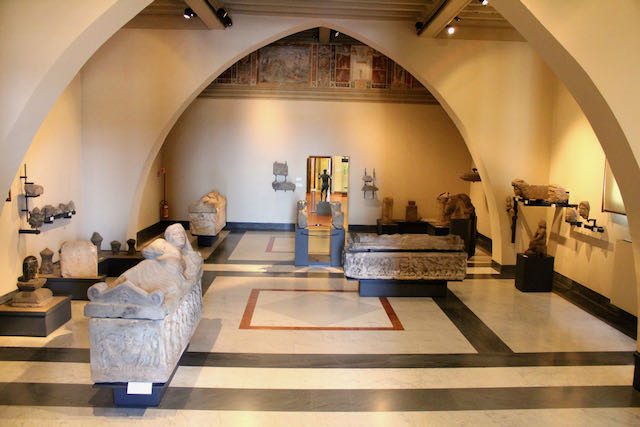 There is a superb collection of Etruscan antiquities in the Vatican Museums
There is a superb collection of Etruscan antiquities in the Vatican MuseumsVatican Museum Must Sees - Rotunda Room and Porphyry Basin
The Sala Rotonda, or Rotunda Room, of the Vatican Museums has a lot going for it.
First of all, it is modelled after the Pantheon, right down to oculus in the ceiling, and to the decorative rosettes in each of the little niches in the dome.
It is smaller in scale than the pantheon but still impressive.
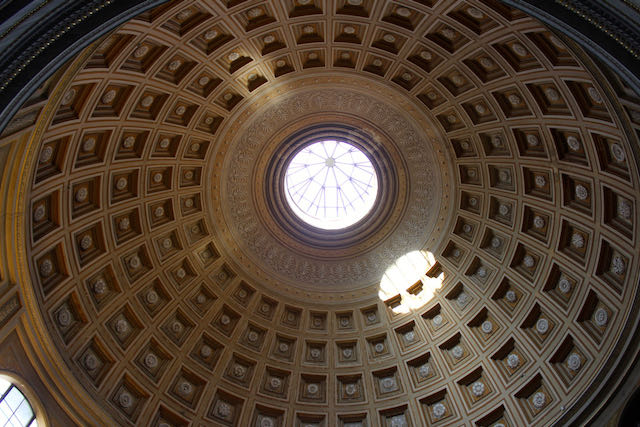 The Sala Rotonda in the Vatican Museums is modelled after the pantheon right down to the oculus in the ceiling
The Sala Rotonda in the Vatican Museums is modelled after the pantheon right down to the oculus in the ceilingSecond, the floor is also not to be missed.
It is made up of tiny, intricately designed mosaics from around the 2nd century and is simply stunning.
These mosaics used to decorate an ancient Roman villa and are incredibly intact and colorful.
There are other ancient black and white mosaics in the room that you can even walk on ... something I find shocking, but you can!
 This giant porphyry basin was part of Nero's Golden House, and was made from a single piece of stone
This giant porphyry basin was part of Nero's Golden House, and was made from a single piece of stoneThird, but definitely not least, is the giant (about 40-feet in diameter) porphyry basin in the center of the room.
What is porphyry?
There are two answers to this:
The first answer is that it is a type of igneous rock (which means it was created from cooled lava), that is full of large pieces of crystal.
The rock is extremely hard, and difficult to cut.
And unbelievable heavy.
So imagine about 2000 years ago, the emperor Nero ordering a bath for his Domus Aurea (Golden House), and having someone get this giant rock out of Egypt (there is one quarry in Ancient Egypt where all the porphyry rock came from) ... and then carve it into a single piece like this and get it to Rome?
The second answer as to what is porphyry is that it is a color.
The word comes from the Greek word for purple, and in ancient Rome, purple was for royalty.
This particular basin is a reddish purple.
Basically, when you see porphyry marble around Rome, just know it was hauled over here from Egypt, and it must have been for a pretty special person.
So do I need to tell you why this room and the basin are in my Top 10 List of Vatican Museum Must Sees?
The shape of the room, the exquisite, detailed mosaics on the floor, and this giant, amazing porphyry bathtub.
It's truly awesome in every sense of the word.
NEW FOR 2024!
The archeological area of the Vatican Necropolis of Via Triumphalis is now open for visitors.
This is an ancient Roman burial site that is within the Vatican walls and before now was very difficult to get access to.
You can only enter as part of an official Vatican tour group, and tickets need to be purchased through the official website.
This is an entirely separate visit, so you will not have access to either St Peter's Basilica or the Vatican Museums.
Click here to watch my YouTube video about it and see what it's like!
Vatican Museum Must Sees - The Tapestries Hall
It's impossible to miss a visit to the Galleria degli Arazzi, or the Tapestry Hall, as you literally have to walk through it to get to the Sistine Chapel.
But it could be easy to breeze past these special works of art, and not really know what exactly you should look at.
Most tours cover at least some of the tapestries room, but in case you are on your own, take some time to notice these things:
First of all, look up.
The ceiling looks like a plaster 3-dimensional design.
It's actually painted!
As for the tapestries, they are from two different periods and regions.
The ones on the right were made in the 17th century in Rome for Pope Urban VIII (Barberini), depicting scenes from his life.
These are nice but the most amazing tapestries are along the left wall.
Here you have tapestries woven in Brussels by Pieter van Aelst’s School, from the 1500's.
They made the tapestries based on drawings by Raphael’s pupils, during the pontificate of Clement VII.
These tapestries depict the life of Jesus.
Each tapestry took years to make.
They were finely woven by the best weavers of the day (who were in Flanders, or Belgium), out of wool but also silk, and gold and silver thread.
Notice in particular the tapestry of The Resurrection of Christ (below).
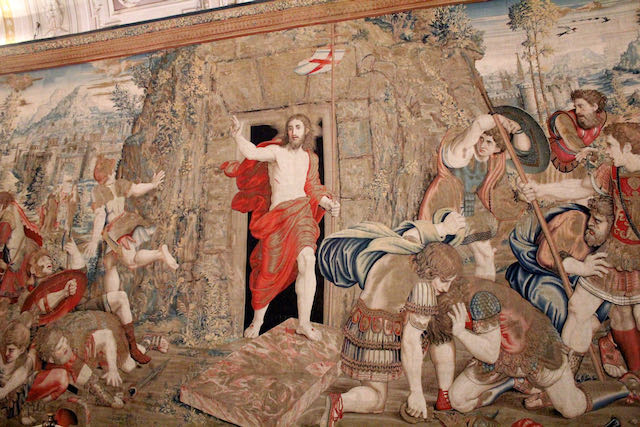 The Resurrection of Christ in the Tapestries Gallery of the Vatican Museums is an amazing work of art and craftsmanship - don't miss it!
The Resurrection of Christ in the Tapestries Gallery of the Vatican Museums is an amazing work of art and craftsmanship - don't miss it!My photo cannot do this tapestry justice.
You have to really look closely to see how amazing this weaving is.
Notice all the shading and even how the weavers were able to depict human emotion...using thread!
But the most amazing part of this particular tapestry?
As you approach it from the left, keep your eyes on Jesus's eyes ... keep walking and watch his eyes.
By the time you pass the tapestry, the eyes are still with you!
It's a wonderful example of "moving perspective", a technique you find sometimes in paintings (like the Mona Lisa.)
But to do this with a tapestry takes a lot more mastery and talent, and requires some very fancy stitching indeed!
Why is the Tapestry Gallery in my Top Ten list of Vatican Museum Must Sees?
Because even though you will visit it anyway, you should pay attention to some of the detail in here, on the ceiling and on these amazing tapestries, in particular the Resurrection tapestry.
Besides the fact that I always love seeing people's faces when they realize the eyes have followed them, I think this level of work and craftsmanship deserves some attention.
Skip the long lines for the Vatican Museums, including the Tapestry Hall
Vatican Museum Must Sees - The Maps Hall
After you go through the Tapestries Gallery, you will inevitably pass through the Galleria delle Carte Geografiche (Maps Gallery).
As with the Tapestries Hall, it would be easy to just coast through here, beelining for the Sistine Chapel.
In the case of the Maps Gallery, it's pretty hard not to notice the ceiling, a must-see all by itself (and one of the most photographed ceilings in the museums besides Michelangelo's Sistine Chapel!)
The Gallery of Maps contains the largest collection of geographical paintings ever created.
These wall-sized maps depict Italy and Italian provinces, and were commissioned by Pope Gregory XIII in the 16th century.
These maps, based on drawings by the Dominican Monk Ignazio Danti, are amazingly accurate for being made in the 1500's!
The maps are really well-detailed, showing mountain ranges and even boats in the water, but they are also somewhat whimsical, containing fantastic sea creatures and even Neptune, the Roman god of the sea.
Why is the Maps Room on my Top Ten List of Vatican Museum Must Sees?
As with the Tapestries Gallery, it's too easy to walk through here without really looking at the art.
But the maps are really genius, and even fun to look at.
See if you can find the depictions of Neptune in some of the maps!
So, exactly what is the Vatican?
Vatican Museum Must Sees - The Papal Apartments
At one time, popes lived inside what is now the Vatican Museums.
This collection of residences is generally called "The Papal Apartments" (and does not have anything to do with where the current pope resides!)
The two most spectacular of these are the Borgia apartments and the Raphael rooms.
These are easily missed/skipped if you want to shortcut to the Sistine Chapel.
But as this page is about what I consider Vatican Museum Must Sees, I am telling you not to miss them!
The Borgia apartments, frescoed by Pinturicchio, a contemporary of Raphael, actually come after the Raphael rooms.
I just wanted to show you what else you would get to see if you include the Raphael Rooms.
It's all wonderful and a feast for the eyes!
Vatican Museum Must Sees - Raphael Rooms and Raphael's School of Athens
While there is a lot to see in the Papal Apartments, we are focusing this page on Vatican Museum Must Sees.
So let's talk about The School of Athens by Raphael.
I think this painting actually makes the top ten list for a lot of people!
It's one of the most famous paintings in the Vatican Museums besides Michelangelo's paintings in the Sistine Chapel.
Renaissance Popes Julius II and Leo X had the best artists of the day decorate their sumptuous homes.
And that meant hiring Raphael.
In 1508 Pope Julius II hired Raphael to paint a room called the Stanza della Segnatura.
This was right after he commissioned Michelangelo to paint the ceiling of the Sistine Chapel!
Can you imagine living in the time and just being able to hire these guys?
In the Stanza della Segnatura, there are actually four paintings by Raphael, one on each wall.
They represent the themes: Theology, Poetry, Philosophy, and Justice.
So enjoy all the Raphael paintings in these rooms but in particular, stop and take note of the School of Athens (philosophy.)
The painting is a fantasy gathering of the greatest philosophers, mathematicians and thinkers from classical antiquity.
They are all together in this one painting even though they came from different places and different moments in time.
That's already whimsical in itself.
But what Raphael did was even more fun.
He put the faces of his contemporaries in there.
Plato, in the center talking to Aristotle, has Leonardo Da Vinci's face.
Another Renaissance master, Donato Bramante (who designed the Belvedere Courtyard we talked about above, and was the first one to design the dome for St. Peter's Basilica), appears on Euclid's body (he's the one drawing on a chalkboard.)
Raphael himself is also in there, on the bottom right corner, looking out at us.
And, while Raphael was painting this extraordinary masterpiece, he popped into the Sistine Chapel and saw what Michelangelo was doing ... and put Michelangelo front and center of The School of Athens, in the form of the Greek philosopher Heracleitus (he is the one resting his head on his arm, and with boots on, sitting on the steps.)
What is so special about Raphael's School of Athens and why is it in my Top Ten List of Vatican Museum Must Sees?
Many art historians and experts consider Raphael's School of Athens one of the greatest paintings of the High Renaissance.
His use of the Renaissance color palette, and mix of ancient and contemporary Roman architectural elements to create unity in the painting, and the theme itself (a coming together of earthly and godly elements), all turn this painting into one of the greatest masterpieces of the Renaissance.
Ready to plan your trip?
Book your train
Planning to travel between cities in Italy and other parts of Europe?
Use Trainline to see all the different options available across the different rail companies.
Find your hotel
Find your perfect place to stay in Rome.
Use Booking.com to choose between hotels, guesthouses, and self-catering apartments in neighborhoods throughout the Eternal City.
Buy your TurboPass
Purchase the convenient Turbopass and visit all of Rome's top attractions including the Colosseum, Pantheon, and Vatican.
With one handy pass, it's all included.
Vatican Museum Must Sees - The Sistine Chapel
VESPERS INSIDE THE SISTINE CHAPEL
I once had the amazing privilege of attending Vespers inside the Sistine Chapel.
Take a look:
And of course, no visit to the Vatican Museums would be complete without the Sistine Chapel.
In fact, it's usually the only reason people come to the Vatican Museums.
And since it is at the very end of the museums, you won't miss it.
When you have a tour of the Vatican Museums, they will give you an explanation of the chapel before you go in, since you are supposed to be quiet in there.
If you go in on your own, here is what to look for once you are inside the Sistine Chapel:
Vatican Museum Must Sees - The Creation of Adam by Michelangelo
These are 9 scenes from the book of Genesis.
And the most famous painting in this series, perhaps one of the most iconic paintings in the world, is the Creation of Adam.
But take the time to look at the rest of the panels on the ceiling too.
Michelangelo and the Pope's Ceiling
by Ross King
I LOVE this book, and cannot recommend it highly enough.
If you want to know all about Michelangelo and how he came to paint the ceiling of the Sistine Chapel, I suggest you get this book.
I found myself surprised to find it was a page-turner that I could not put down!
Vatican Museum Must Sees - Michelangelo's Last Judgement
Every time I visit the Sistine Chapel, I notice everyone looking straight up.
Yes, the star attraction is Michelangelo's ceiling, in particular, the Creation of Adam.
And with good reason.
It's spectacular.
And one of the world's most famous pieces of art.
So get a good look and enjoy.
But also, take the time to enjoy some other things in here as well, especially Michelangelo's other great masterpiece in this room: The Last Judgement.
This painting was done later, between 1535 and 1541.
And by this time, Michelangelo was in his sixties.
He'd thought he was done with painting ... he'd thought of himself primarily as a sculptor.
But the new Pope Paul III (Farnese), convinced Michelangelo he had more in him, as a painter but also as an architect.
So he had Michelangelo finish St. Peter's Basilica.
(And also redesign Capitoline Hill, but that is another story.)
And the Pope had Michelangelo paint Il Giudizio Universale, The Last Judgement.
The painting shows the second coming of Christ on the Day of Judgment (Revelation of John.)
Notice Jesus' position in the center, he is neither standing nor sitting, but almost in motion.
On the bottom left are the souls selected for passage to heaven, and on the bottom right, are the damned souls being transported to hell by Charon on the river Styx.
Michelangelo painted The Last Judgement after the Sack of Rome in 1527.
Also, he'd become much more devout as he'd gotten older, and had a lot of inner conflict about his younger, more pagan days.
So the painting has a considerably darker feeling about it than the ceiling panels.
And, if you look closely at the flayed skin of St. Bartholomew, just below Jesus and to our right, you can see that is Michelangelo's face.
It was his way of atoning.
This painting is for me one of THE Vatican Museum Must Sees, as it shows a transition for Michelangelo, and so much drama and raw human emotion than many of his previous paintings.
Disclosure: If you make a purchase through a link on this page, I may receive a small commission - at no extra cost to you. Thank you for supporting my site!
Vatican Museum Must Sees - The Cosmatesque Floor of the Sistine Chapel
And speaking of looking not only up and around, look down, too.
This beautiful floor has a pattern called "Cosmatesque", so named for the Cosmati family that created this style and decorated churches around Italy, and particularly in Rome, in the 12th and 13th centuries.
It's also included in some walking tours like this one.
Finally, in the last of my list of Vatican Museum Must Sees inside the Sistine Chapel, don't miss the wall panels underneath the ceiling.
Before Michelangelo came along and eclipsed their fame with his paintings, Pope Sixtus IV (for whom the Sistine Chapel is named), had the walls painted by Renaissance masters including: Sandro Botticelli, Pietro Perugino, Pinturicchio, and Domenico Ghirlandaio (one of Michelangelo's mentors.)
These frescos depict the Life of Moses and the Life of Christ, and truly are Vatican Museum Must Sees in their own right.
To conclude, there are many "Vatican Museum must sees", including works I've left off this list.
But I do hope this will give you some idea of things you might wish to include on your visit to the Vatican Museums, in particular, some things you might not have thought to see.
No matter what you see/don't see, a visit to the Vatican Museums is one of the most special, exciting, and beautiful things you can do in Rome!
Of course you already know by now that the Sistine Chapel is at the top of everyone's list of Vatican Museum must sees.
In fact, it may be the ONLY thing people want to see when they visit these museums.
But since it's not possible to see only the Sistine Chapel, I hope you will enjoy some of the other masterpieces there too.
Click here to visit the Vatican Museums website to view a map of the museums.
Did you know that if you book a visit to the Vatican Gardens, you automatically have a skip-the-line-ticket into the Vatican Museums?
Romewise's Top Travel Resources
Ready to book your trip to Rome? Take a look at these helpful links to companies we use and trust:
- Keep your travel spending simple with the Wise card, which removes all the worry about exchange rates and high transaction fees all over the world
- Search for and book your perfect accommodation
- Our complete guide to what to pack for Rome
- The number one travel accessory, a multi-point travel adapter and voltage converter
- Browse a huge range of tours in Rome and beyond
- Experience unique tours and special access to Rome's most popular sights
- Protect yourself with comprehensive travel insurance
Within this post there are some affiliate links for products and services. For more details about our affiliate policy click here.
Get your 100% free Rome trip planner now!
Simply sign-up today for our free newsletter and get the Romewise Quick Start guide to Rome:
We are committed to respecting your data. Click for our Privacy Policy.
Comments? Questions? Suggestions?
Please come over to the private Romewise Facebook group and join in the conversation.
You will often find me there, happy to answer your questions / comments!
You will also meet other Rome lovers and experts, too.
What are you waiting for?
- Romewise Home Page
- Visiting the Vatican
- Vatican Museum Must Sees

